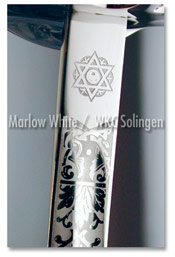Marlow White's swords and sabers have ceremonial blades. As such, they are built to strict military regulations to be used in drills, ceremonies, and displays. These blades are of the highest quality but are not sharpened for use as a weapon.
Six-pointed star on U.S. swords
 First, the star is not a Star of David because it is geometrically different. The Star of David does not consist of two triangles combined together, but rather two, separate, interlocking triangles (which, in recent history, and often when displayed in one-color designs, usually does appear to be two triangles combined together).
First, the star is not a Star of David because it is geometrically different. The Star of David does not consist of two triangles combined together, but rather two, separate, interlocking triangles (which, in recent history, and often when displayed in one-color designs, usually does appear to be two triangles combined together).
We cannot absolutely confirm the history of the star; however, we do know that the blade specifications for both the U.S. and British military swords require the six-pointed star with the word "Proved" etched on the blade.
As best we can tell, the specification for the six-pointed star is historical in nature and was likely used to signify that the blade was manufactured using the Damascus steel method. Today, there is no requirement for Damascus steel blades; however, the six-pointed "Proved" star is required in the etch to signify that the blade meets the current military specifications. Even this use has lost its meaning, however, since replica swords intended only for wall-mounting incorrectly bear the symbol.
Damascus steel was perfected by the Persians and was reportedly encountered by Alexander the Great three centuries before Christ. The Persians used the six-pointed star during these non-modern times. The Persian blade-making process of folding the steel many times - even hundreds of times - to layer the steel resulted in extremely tough blades with both strength and resilience. The term "Damascus steel" came from western traders first encountering the steel in Damascus.
Today, U.S. military blades are purely ornamental and ceremonial in nature. The modern-day swords and sabers are certainly not made with Damascus steel blades and are not made to withstand blade-to-blade contact. Damascus steel blades today would cost tens of thousands of dollars to forge, and we know of no one who offers Damascus steel blades.
 First, the star is not a Star of David because it is geometrically different. The Star of David does not consist of two triangles combined together, but rather two, separate, interlocking triangles (which, in recent history, and often when displayed in one-color designs, usually does appear to be two triangles combined together).
First, the star is not a Star of David because it is geometrically different. The Star of David does not consist of two triangles combined together, but rather two, separate, interlocking triangles (which, in recent history, and often when displayed in one-color designs, usually does appear to be two triangles combined together).
We cannot absolutely confirm the history of the star; however, we do know that the blade specifications for both the U.S. and British military swords require the six-pointed star with the word "Proved" etched on the blade.
As best we can tell, the specification for the six-pointed star is historical in nature and was likely used to signify that the blade was manufactured using the Damascus steel method. Today, there is no requirement for Damascus steel blades; however, the six-pointed "Proved" star is required in the etch to signify that the blade meets the current military specifications. Even this use has lost its meaning, however, since replica swords intended only for wall-mounting incorrectly bear the symbol.
Damascus steel was perfected by the Persians and was reportedly encountered by Alexander the Great three centuries before Christ. The Persians used the six-pointed star during these non-modern times. The Persian blade-making process of folding the steel many times - even hundreds of times - to layer the steel resulted in extremely tough blades with both strength and resilience. The term "Damascus steel" came from western traders first encountering the steel in Damascus.
Today, U.S. military blades are purely ornamental and ceremonial in nature. The modern-day swords and sabers are certainly not made with Damascus steel blades and are not made to withstand blade-to-blade contact. Damascus steel blades today would cost tens of thousands of dollars to forge, and we know of no one who offers Damascus steel blades.